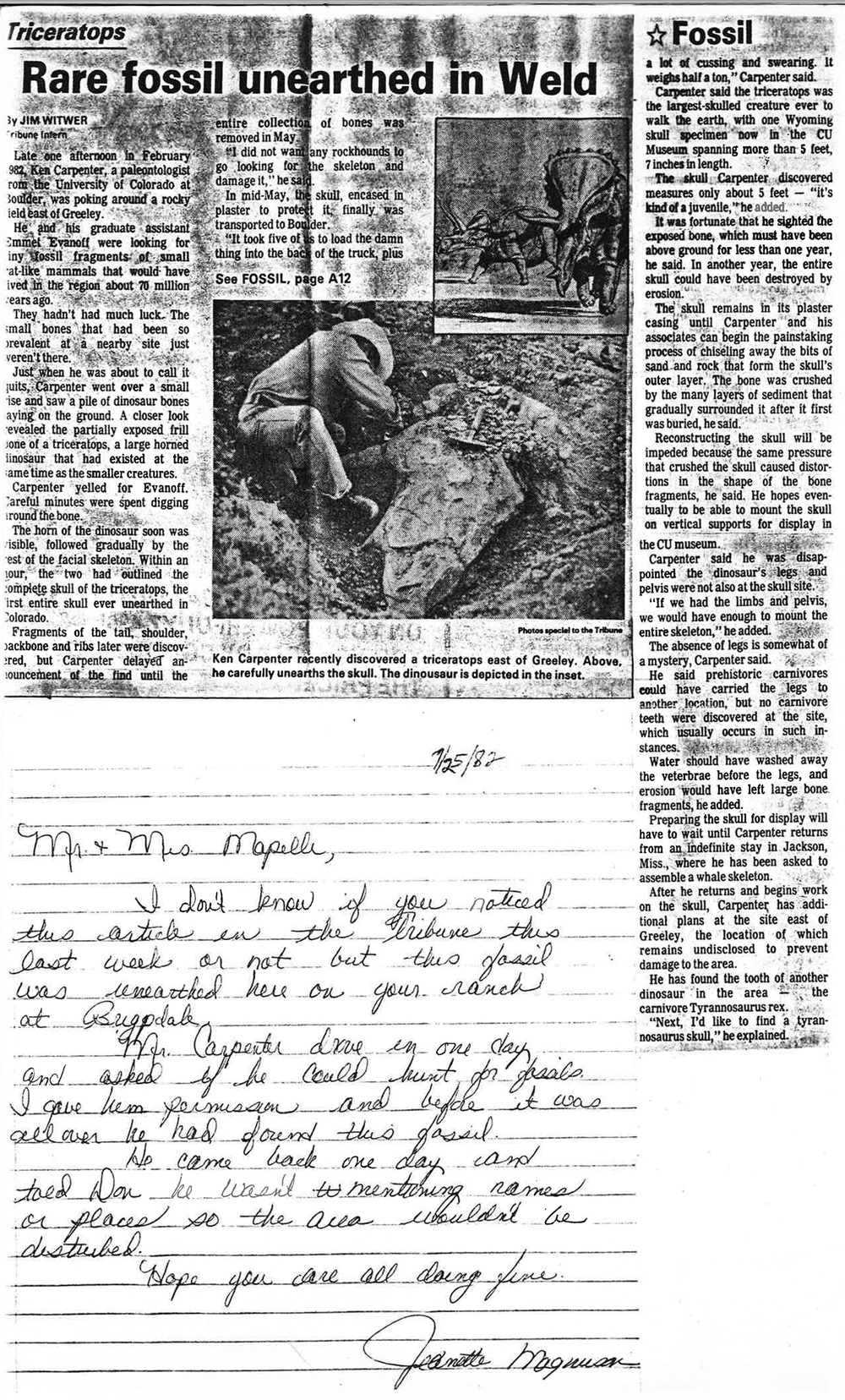
Tribune Article Transcription
Rare fossil unearthed in Weld
By Jim Witwer
Late one afternoon in February 1982, Ken Carpenter, a paleontologist from the University of Colorado at Boulder, was poking around a rocky field east of Greeley.
He and his graduate assistant, Emmet Evanoff, were looking for tiny fossil fragments of small rat-like mammals that would have lived in the region about 70 million years ago.
They hadn't had much luck. The small bones that had been so prevalent at a nearby site just weren't there.
Just when he was about to call it quits, Carpenter went over a small rise and saw a pile of dinosaur bones laying on the ground. A closer look revealed the partially exposed frill bone of a triceratops, a large horned dinosaur that had existed at the same time as the smaller creatures.
Carpenter yelled for Evanoff. Careful minutes were spent digging around the bone.
The horn of the dinosaur soon was visible, followed gradually by the rest of the facial skeleton. Within an hour, the two had outlined the complete skull of the triceratops, the first entire skull ever unearthed in Colorado.
Fragments of the tail, shoulder, backbone and ribs later were discovered, but Carpenter delayed announcement of the find until the entire collection of bones was removed in May.
"I did not want any rockhounds to go looking for the skeleton and damage it," he said.
In mid-May, the skull, encased in plaster to protect it, finally was transported to Boulder.
"It took five of us to load the damn thing into the back of the truck, plus a lot of cussing and swearing. It weighs half a ton," Carpenter said.
Carpenter said the triceratops was the largest-skulled creature ever to walk the earth, with one Wyoming skull specimen now in the CU Museum spanning more than 5 feet, 7 inches in length.
The skull, Carpenter discovered, measures only about 5 feet - "it's kind of a juvenile," he added.
It was fortunate that he sighted the exposed bone, which must have been above ground for less than one year, he said. In another year, the entire skull could have been destroyed by erosion.
The skull remains in its plaster casing until Carpenter and his associates can begin the painstaking process of chiseling away the bits of sand and rock that form the skull's outer later. The bone was crushed by the many layers of sediment that gradually surrounded it after it first was buried, he said.
Reconstructing the skill will be impeded because the same pressure that crushed the skull caused distortions in the shape of the bone fragments, he said. He hopes eventually to be able to mount the skull on vertical supports for display in the CU museum.
Carpenter said he was disappointed the dinosaur's legs and pelvis were not also at the skull site.
"If we had the limbs and pelvis, we would have enough to mount the entire skeleton," he added.
The absence of legs is somewhat of a mystery, Carpenter said.
He said prehistoric carnivores could have carried the legs to another location, but no carnivore teeth were discovered at the site, which usually occurs in such instances.
Water should have washed away the vertebrae before the legs, and erosion would have left large bone fragments, he added.
Preparing the skull for display will have to wait until Carpenter returns from an indefinite stay in Jackson, Miss., where he has been asked to assemble a whale skeleton.
After he returns and begins work on the skull, Carpenter has additional plans at the site east of Greeley, the location of which remains undisclosed to prevent damage to the area.
He has found the tooth of another dinosaur in the area - the carnivore Tyrannosaurus rex.
"Next, I'd like to find a tyrannosaurus skull," he explained.
Magnuson Letter Transcription
Dated July 25, 1982
Mr. and Mrs. Mapelli,
I don't know if you noticed this article in the Tribune this last week or not, but this fossil was unearthed here on your ranch at
Mr. Carpenter drove in one day and asked if he could hunt for fossils. I gave him permission and before it was all over, he had found this fossil.
He came back one day and told Don he wasn't mentioning names or places so the area wouldn't be disturbed.
Hope you are all doing fine.
Jeanette Magnuson